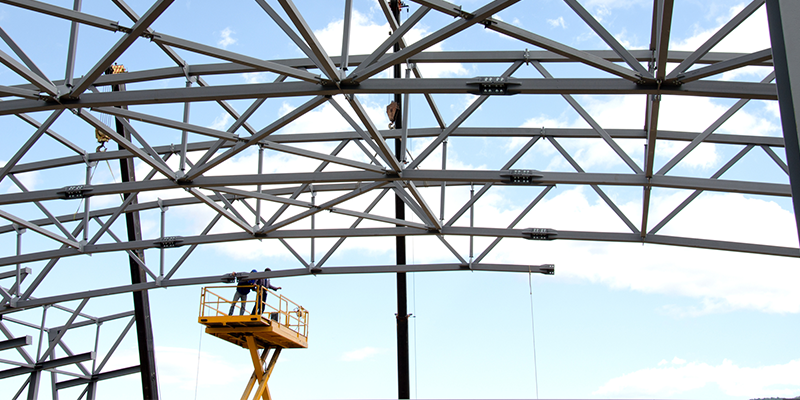As the industrial market sees some cooling from pandemic-era highs and financing tightens, what should owners and investors expect over the next 12-18 months? Four national experts took the stage at I.CON West to discuss what lies ahead for this popular asset class.
Capital Raising is Down, Cash is King
Overall, institutional capital raising was down 30-40% in 2023. Institutional investors have been wary of open-ended funds, portfolios have been trimmed and deals are happening increasingly in cash. Considering the current lending environment, more investors prefer unlevered deals.
“I’m always surprised how many groups out there are willing to buy all cash,” said Christy Gahr, director of capital markets, North America, Realterm. “It’s taken off over the last year, especially when the cost of debt is 6%.”
The private equity market is active, and panelists said they see more investment coming from end users. On the debt side, banks are shying away from speculative development projects and focused on smaller transactions last year. Some investors are taking more of a “rifle shot” approach by focusing on targeted, specific projects rather than casting a wide net. There is also interest from life companies that have some liquidity to invest in stabilized industrial product in first-tier markets.
Not Much Distress, But More Scrutiny
PJ Charlton, chief investment officer, CenterPoint Properties, commented he wasn’t seeing much distress and certainly not at 2009 levels. However, there are motivated sellers. It is a suitable time to sell assets out of a fund due to the high leasing rates and spectacular rent growth. “Most sellers today have a reason,” said Tim Walsh, chief investment officer, Dermody, “whether it’s a balance sheet-motivated, whether it’s related to some sort of tax structuring or promises they’ve made to investors.”
What has changed over the past 2-3 years is the approach of investment committees. “Back then it was about aggregation,” said Charlton. “It was all in on industrial… rents were growing 15% a year, cap rates are down another 50 basis points. Interest rates are 3%… Investment committees are reading every page and scrutinizing every word now. It’s a much more discerning buyer than it was three years ago,” he said. Investment committees are focusing on projects in healthy rent growth markets such as New Jersey, Los Angeles and Miami with $50 million-$150 million deal ranges.
“There is a thesis that there’s a slowdown in developments in all our markets,” said Walsh. “Everyone sees it. There are some submarkets where there weren’t any groundbreakings in the first quarter.” However, there will be an overall return to a balanced supply and demand dynamic.
Embracing ESG
Investors and tenants are increasingly recognizing the importance of ESG, and the panel agreed bigger credit and quality tenants tend to be more environmentally focused. Dermody has increased its environmental standards, making sure each of their building roofs can structurally support solar panels and installing piping and wiring the parking lots for electric charging. “There is a lot of noise out there when it comes to NIMBYism,” said Walsh, “And I think we need to do more to promote the modern environmentally sensitive product that we’re all building.”
Additionally, power supply is becoming more of a concern. “Several years ago, everyone was talking about having the right amount of parking. Now the hot topic is having access to power supply,” said Charlton. Several Fortune 500 companies, including FedEx, have promised to reduce their carbon footprint quickly and that means access to electrified parking. “What we’re seeing is that parking is even more important because now you have fleets that need to be able to charge two or three times a day in last-mile distribution facilities,” said Gahr. “It will change aspects of how we invest and how we underwrite and think about what our properties need to be able to provide our users.”
Nearshoring and Onshoring
Jack Fraker, president and global head of industrial and logistics capital markets for Newmark, turned the discussion to what is happening near the U.S.-Mexico border and asked the panelists what they are seeing in terms of nearshoring. Gahr commented that so much has changed in a short period and cited several statistics. For example, since 2019, China alone has invested in more than 120 projects in Mexico and in over 18 million square feet of industrial space. U.S.-Mexico trade is now outpacing U.S.-China trade by more than 40%.
“During the first half of 2023, $461 billion of goods passed through the U.S.-Mexico border, which is 44% higher than the value of goods between U.S. and China,” said Gahr. More than 150 foreign companies said in 2023 that they will open a new operation or expand into Mexico. These sectors include automotive, energy, manufacturing and IT.
Texas cities Laredo and El Paso were identified as active border markets, and the panelists agreed the best-performing assets are going to be as close to the border as possible. In 2023, El Paso had over three million square feet in total net absorption with a market wide vacancy of less than 4%, according to CBRE. The panelists also discussed the tremendous amount of opportunity in Mexico, although many U.S. development companies have not yet chosen to invest there. Onshoring activity, such as a Samsung project in Austin, is also on the rise.
Overall, the panel remained optimistic about investments, the economy and interest rates. Unemployment is below 4% and the economy is still growing. Additionally, the level of capital that’s sitting in money markets right now is “at $6 trillion – and that’s $2 trillion higher than it was five years ago,” according to Walsh. “So, the giant pile of money persists. And it’s available as soon as people are comfortable coming off the sidelines.”

This post is brought to you by JLL, the social media and conference blog sponsor of NAIOP’s I.CON West 2024. Learn more about JLL at www.us.jll.com or www.jll.ca.














